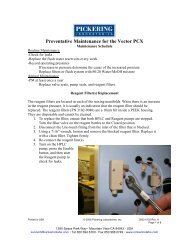to download our North American Product Catalog - Pickering ...
to download our North American Product Catalog - Pickering ...
to download our North American Product Catalog - Pickering ...
Create successful ePaper yourself
Turn your PDF publications into a flip-book with our unique Google optimized e-Paper software.
METHOD ABSTRACTS112 / EXPANDED HPLC METHOD FOR N-METHYL CARBAMATESPOST-COLUMN ANALYSIS OF PESTICIDES IN FOOD AND POTABLE WATER SAMPLESCarbamate pesticides are widely used around the world <strong>to</strong> protect crops. In addition, they are used as biocides for industrialor other applications and in household products. Though carbamates are biodegradable compounds and bioaccumulationusually happens only <strong>to</strong> a low extend it is important <strong>to</strong> moni<strong>to</strong>r produce <strong>to</strong> make sure enough time has elapsed betweenharvest and applying pesticides. Also, because of their high solubility, carbamates can leach in<strong>to</strong> ground waters in poroussoils and consequently nd their way in<strong>to</strong> drinking water supplies.As part of FDA’s pesticide moni<strong>to</strong>ring program individual lots of domestic and imported foods and feeds are sampled andtested for pesticide residues <strong>to</strong> enforce the <strong>to</strong>lerances set by EPA. There are 11 compounds mandated by USEPA Method531.2 for drinking water but they represent only a fraction of the carbamates that require moni<strong>to</strong>ring in domestic andimported products. Methyl carbamates are separated using a reversed-phase column and then readily react with o-Phthalaldehydeand a mercaptan after hydrolysis <strong>to</strong> form highly uorescence compounds. This post-column reaction is the basis forofcial EPA Method 531.2 and AOAC Method 985.23.This new expanded method is suitable for detecting a wide range of carbamates; post-column derivatization with uorescencedetection is a sensitive and selective method for residue analysis in water, food and feed samples. This methodemploys the same HPLC and post-column equipment and chemicals as USEPA Method 531.2 and will allow labora<strong>to</strong>ries<strong>to</strong> increase the range of tested compounds.The separation is achieved on a C 8stationary phase with a water/Methanol gradient. Differences in selectivity of a water/Ace<strong>to</strong>nitrile gradient may be used for conrmation.METHODAnalytical ConditionsColumn: Expanded resolution C 8analytical column 4x250 mm,P/N 0840250 Guard column P/N 18ECG001Flow Rate: 0.8 mL/minColumn Temperature: 50 CMobile Phase: Water/MethanolPost-column ConditionsPost-column System: Pinnacle PCX or Vec<strong>to</strong>r PCXReac<strong>to</strong>r Volume: 0.5 mLReac<strong>to</strong>r Temperature: 100 CReagent 1: CB130Reagent 2: 100 mg of OPA and 2 g of Thiouor in 950 mLof CB910 DiluentReagents Flow Rate: 0.3 mL/minDetection:Fluorescence Detec<strong>to</strong>r ex= 330 nm, em= 465 nmHPLC Gradient:TIME WATER % METHANOL %0 85 152 85 1542 30 7046 30 7046.1 0 10050 0 100Equilibration: 10 minACKNOWLEDGEMENTS:<strong>Pickering</strong> Labora<strong>to</strong>ries would like <strong>to</strong> thank John Casanova and Frank Schenck (FDA) fortheir help with this project.



